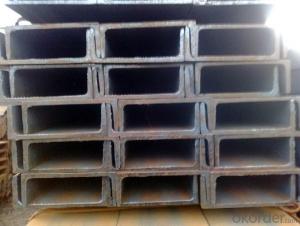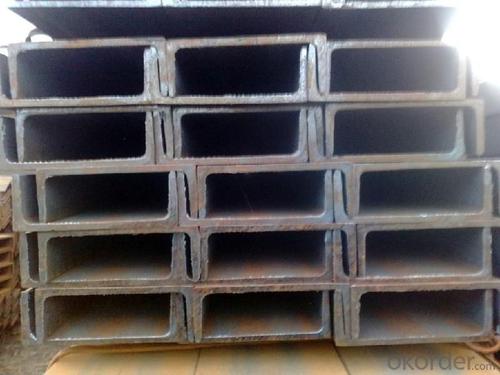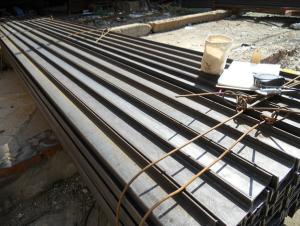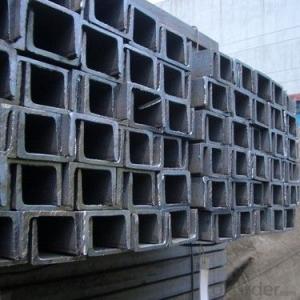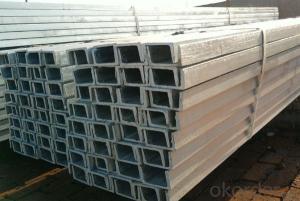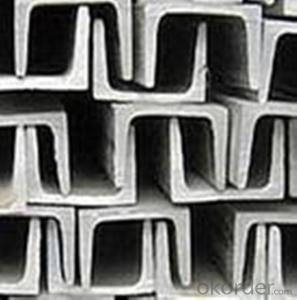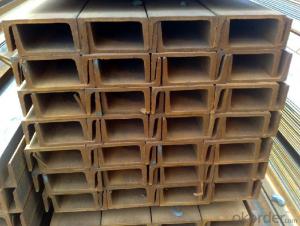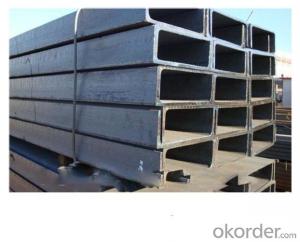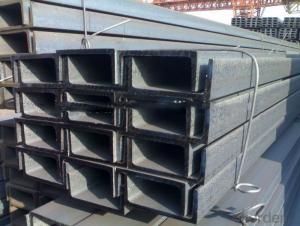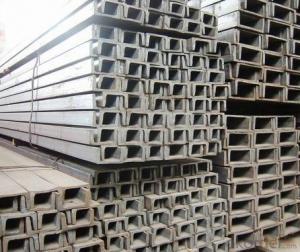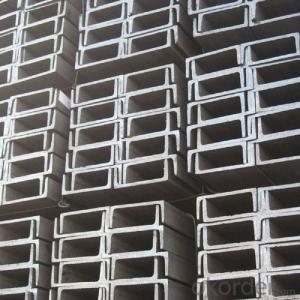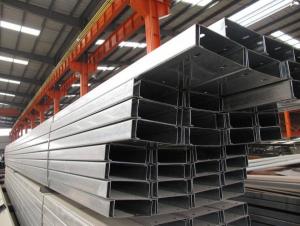Custom Steel Channel (55mm X 6mm)
- Loading Port:
- Qingdao
- Payment Terms:
- TT or LC
- Min Order Qty:
- 10 m.t.
- Supply Capability:
- 5000 m.t./month
OKorder Service Pledge
OKorder Financial Service
You Might Also Like
Custom Steel Channel (55mm X 6mm)
OKorder is offering high quality Custom Steel Channels at great prices with worldwide shipping. Our supplier is a world-class manufacturer of steel, with our products utilized the world over. OKorder annually supplies products to European, North American and Asian markets. We provide quotations within 24 hours of receiving an inquiry and guarantee competitive prices.
Product Applications:
Custom Steel Channels are ideal for structural applications and general fabricating.
Product Advantages:
OKorder's Steel Channels are durable, strong, and resists corrosion.
Main Product Features:
· Premium quality
· Prompt delivery & seaworthy packing (7-10 days after receiving deposit)
· Corrosion resistance
· Can be recycled and reused
· Mill test certification
· Professional Service
· Competitive pricing
Product Specifications:
Base Model
Grade: Q195 / Q235 / Q215 / Q345 / SS400 / S235JR, A36, SS400, SS540, ASTM A36
Height: 55 – 400mm
Thickness: 6 – 14.5mm
Length: As per customer request
Max Dimensions: 55*37*6mm – 400*104*14.5mm
Surface: Painted, galvanized, as per customer request
Punch: Punched as per customer request
Light Model
Grade: Q195 / Q235 / Q215 / Q345 / SS400 / S235JR, A36, SS400, SS540, ASTM A36
Height: 50 – 400mm
Thickness: 6 – 8.0mm
Length: As per customer request
Max Dimensions: 50*32*6mm – 400*115*8.0mm
Surface: Painted, galvanized, as per customer request
Punch: Punched as per customer request
FAQ:
Q1: Why buy Materials & Equipment from OKorder.com?
A1: All products offered byOKorder.com are carefully selected from China's most reliable manufacturing enterprises. Through its ISO certifications, OKorder.com adheres to the highest standards and a commitment to supply chain safety and customer satisfaction.
Q2: How do we guarantee the quality of our products?
A2: We have established an advanced quality management system which conducts strict quality tests at every step, from raw materials to the final product. At the same time, we provide extensive follow-up service assurances as required.
Q3: How soon can we receive the product after purchase?
A3: Within three days of placing an order, we will begin production. The specific shipping date is dependent upon international and government factors, but is typically 7 to 10 workdays.
Q4: What makes stainless steel stainless?
A4: Stainless steel must contain at least 10.5 % chromium. It is this element that reacts with the oxygen in the air to form a complex chrome-oxide surface layer that is invisible but strong enough to prevent further oxygen from "staining" (rusting) the surface. Higher levels of chromium and the addition of other alloying elements such as nickel and molybdenum enhance this surface layer and improve the corrosion resistance of the stainless material.
Q5: Can stainless steel rust?
A5: Stainless does not "rust" as you think of regular steel rusting with a red oxide on the surface that flakes off. If you see red rust it is probably due to some iron particles that have contaminated the surface of the stainless steel and it is these iron particles that are rusting. Look at the source of the rusting and see if you can remove it from the surface.
Images:

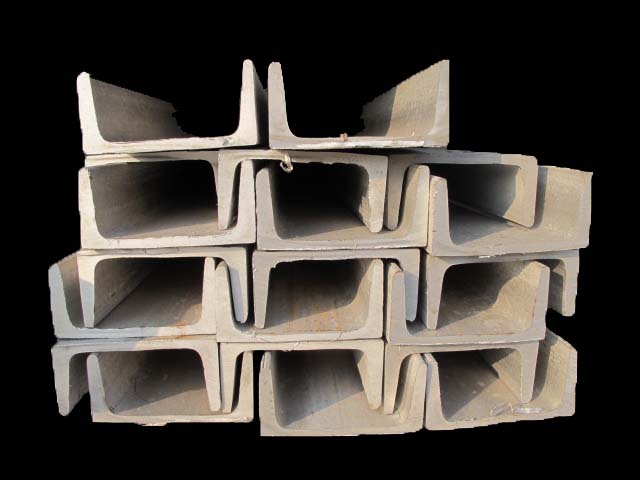


- Q: How is a steel channel made?
- A steel channel is typically made through a process called hot rolling. The process starts with heating a large rectangular steel billet until it reaches a malleable temperature. The billet is then passed through a series of rollers, which progressively shape it into the desired channel shape. During the hot rolling process, the billet is continuously squeezed and elongated by the rollers, reducing its thickness and increasing its length. The rollers have grooves that determine the final shape of the channel. The channel section can vary, ranging from a simple C-shape to more complex U-shape or even custom profiles. As the billet is shaped, excess material is squeezed out through the sides, leaving behind a clean and defined channel shape. The channel is continuously cooled to prevent warping or distortion during the rolling process. Once the desired length is achieved, the channel is cut into individual pieces based on customer requirements. After the hot rolling process, the steel channels may undergo additional treatments such as straightening, surface cleaning, or coating. These treatments ensure the channels meet the desired specifications and are ready for use in various applications, such as structural support, construction, or manufacturing. Overall, the hot rolling process plays a crucial role in the production of steel channels, enabling the creation of strong and versatile structural components used in numerous industries.
- Q: What are the specifications for steel channel coatings?
- The specifications for steel channel coatings typically include factors such as type of coating material, thickness requirements, adhesion properties, corrosion resistance, durability, and any specific industry standards or regulations that need to be met.
- Q: Can steel channels be customized for specific applications?
- Yes, steel channels can be customized for specific applications. Steel channels are versatile and can be fabricated and modified to meet the specific requirements of different applications. Customization can involve altering the dimensions, shape, or material composition of the steel channel to suit the needs of the application. Additionally, various surface finishes and coatings can be applied to the steel channels to enhance their performance and durability in specific environments or industries. Customization ensures that the steel channels are tailored to fit the unique demands of the application, whether it be in construction, manufacturing, infrastructure, or any other industry where steel channels are utilized.
- Q: Can steel channels be used for mezzanine floors?
- Yes, steel channels can be used for mezzanine floors. Steel channels are commonly used in construction for their strength and durability. They can be used as the primary structural support for mezzanine floors, providing a sturdy framework for the elevated platform. Steel channels can be easily fabricated and installed, making them a practical choice for mezzanine floor construction. Additionally, steel channels can withstand heavy loads and provide sufficient support for various activities such as storage, offices, or additional workspaces. Overall, steel channels are a suitable and commonly used material for constructing mezzanine floors.
- Q: Can steel channels be used in curved designs?
- Yes, steel channels can be used in curved designs. They can be bent or curved to fit the desired shape, making them suitable for various structural applications that require curved designs.
- Q: What are the different methods of connecting steel channels?
- There are several different methods of connecting steel channels, depending on the specific application and structural requirements. Some of the common methods include: 1. Welding: This is one of the most popular methods of connecting steel channels. Welding involves melting the metal in the joint area and fusing it together. It provides a strong and permanent connection. Different types of welding techniques such as arc welding, MIG welding, and TIG welding can be used. 2. Bolting: Bolting involves using bolts, nuts, and washers to connect steel channels. Holes are drilled in the channels, and bolts are inserted through the holes and tightened with nuts. This method allows for easy disassembly and reassembly, making it suitable for applications where frequent adjustments or modifications are required. 3. Riveting: Riveting is a traditional method of connecting steel channels. It involves using rivets, which are cylindrical metal pins, to hold the channels together. The rivets are inserted through pre-drilled holes and then hammered or pressed to secure them. This method provides a strong and durable connection. 4. Adhesive bonding: Adhesive bonding involves using industrial adhesives or epoxy resins to bond steel channels. This method is often used when aesthetics are important, as it does not leave any visible fasteners. However, it may not be suitable for applications requiring high load-bearing capacity. 5. Mechanical connectors: These connectors are specially designed to connect steel channels without the need for welding or drilling. They typically consist of a clamp or bracket that can be secured to the channels using bolts or screws. Mechanical connectors provide a quick and easy method of connection, allowing for efficient installation and disassembly. Overall, the choice of connection method depends on factors such as the load-bearing requirements, structural design, ease of installation, and the need for adjustability or disassembly. Consulting with a structural engineer or a professional in the field is recommended to determine the most appropriate method for a specific application.
- Q: What are the different types of hangers used for steel channels?
- There are several different types of hangers used for steel channels, including clevis hangers, u-bolt hangers, pipe hangers, and beam clamps. These hangers are designed to provide support and secure the steel channels in various applications, such as construction, plumbing, and electrical installations. Each type of hanger has its own specific design and mounting method to accommodate different channel sizes and load capacities.
- Q: Can steel channels be used in framing systems?
- Yes, steel channels can be used in framing systems. Steel channels are commonly used in construction for their strength and durability. They can provide structural support and stability in framing systems, making them an excellent choice for various applications such as walls, roofs, and floors.
- Q: Are steel channels suitable for the power generation manufacturing industry?
- Yes, steel channels are suitable for the power generation manufacturing industry. Steel channels are commonly used in the manufacturing of power generation equipment such as turbines, generators, and transformers. The strong and durable nature of steel makes it an ideal material for supporting heavy loads and withstanding the high temperatures and pressures often encountered in power generation processes. Additionally, steel channels can be easily fabricated and customized to meet the specific design requirements of power generation equipment. They provide stability, structural integrity, and reliability, making them a suitable choice for the power generation manufacturing industry.
- Q: Can steel channels be used in manufacturing equipment?
- Yes, steel channels can be used in manufacturing equipment. Steel channels, also known as C-channels or U-channels, are popular structural components in various industries due to their strength and versatility. They are commonly used to create frames, supports, and structures for machines and equipment. Steel channels provide stability and rigidity, making them suitable for handling heavy loads and withstanding dynamic forces during the manufacturing process. Additionally, steel channels can be easily welded, bolted, or fastened together, allowing for flexible and efficient construction of equipment. Overall, steel channels are a reliable choice for manufacturing equipment due to their durability, strength, and ease of use.
Send your message to us
Custom Steel Channel (55mm X 6mm)
- Loading Port:
- Qingdao
- Payment Terms:
- TT or LC
- Min Order Qty:
- 10 m.t.
- Supply Capability:
- 5000 m.t./month
OKorder Service Pledge
OKorder Financial Service
Similar products
Hot products
Hot Searches
Related keywords
